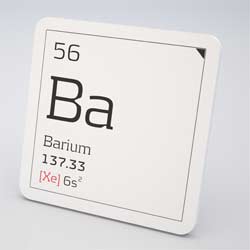
Drinking Water Contaminants - Barium
This is a factsheet about a chemical that may be found in some public or private drinking water supplies. It may cause health problems if found in amounts greater than the health standard set by the United States Environmental Protection Agency (EPA).

What is Barium and how is it used?
Barium is a lustrous, machinable metal that exists in nature only in ores containing mixtures of elements. It is used in making a wide variety of electronic components, in metal alloys, bleaches, dyes, fireworks, ceramics, and glass. In particular, it is used in well drilling operations where it is directly released into the ground.
Why is Barium being regulated?
In 1974, Congress passed the Safe Drinking Water Act. This law requires EPA to determine safe levels of chemicals in drinking water that do or may cause health problems. These non-enforceable levels, based solely on possible health risks and exposure, are called Maximum Contaminant Level Goals.
The MCLG for barium has been set at 2 parts per million (ppm) because EPA believes this level of protection would not cause any of the potential health problems described below.
Based on this MCLG, EPA has set an enforceable standard called a Maximum Contaminant Level (MCL). MCLs are set as close to the MCLGs as possible, considering the ability of public water systems to detect and remove contaminants using suitable treatment technologies.
The MCL has also been set at 2 ppm because EPA believes, given present technology and resources, this is the lowest level to which water systems can reasonably be required to remove this contaminant should it occur in drinking water.
These drinking water standards and the regulations for ensuring these standards are met, are called National Primary Drinking Water Regulations. All public water supplies must abide by these regulations.
What are the health effects?
Short-term: EPA has found barium to potentially cause the following health effects when people are exposed to it at levels above the MCL for relatively short periods of time: gastrointestinal disturbances and muscular weakness.
Long-term: Barium has the potential to cause the following effects from a lifetime exposure at levels above the MCL: high blood pressure.
* Water/Land totals only include facilities with releases greater than a certain amount - usually 1000 to 10,000 lbs.

